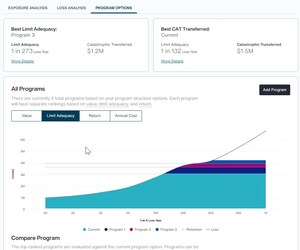CHICAGO, Aug. 6, 2020 /PRNewswire/ -- Aon plc (NYSE: AON), a leading global professional services firm providing a broad range of risk, retirement and health solutions, today launches the latest edition of its monthly Global Catastrophe Recap report, which evaluates the impact of the natural disaster events that occurred worldwide during July 2020.
The report reveals that persistent seasonal rainfall worsened the flood situation across China's Yangtze River Basin during the month, with the death toll since June 1 rising to at least 175, as extensive flooding affected the hardest-hit provinces of Anhui, Hubei and Chongqing municipality. The Ministry of Emergency Management (MEM) noted that nearly 500,000 homes had been damaged or destroyed and 5.2 million hectares (13 million acres) of cropland affected. Direct seasonal economic losses were estimated at CNY150 billion ($22 billion), of which nearly $16 billion occurred in July. Most of the losses were anticipated to be uninsured.
Hurricane Hanna became the earliest eighth-named "H" storm on record in the Atlantic Basin, in addition to being the first hurricane of the 2020 Atlantic Season. Hanna made landfall along the southern Texas coast on July 25 as a 90 mph (150 kph) Category 1 storm. Several feet of storm surge were noted near the landfall location, in addition to hurricane-force wind gusts and torrential rains that prompted inland flooding. Some of the worst flood damage was found in the Rio Grande Valley of Texas into northern Mexico. Total economic losses were estimated into the hundreds of millions of dollars (USD).
Tropical Storm Fay, the earliest sixth-named "F" storm on record in the Atlantic Ocean, killed six people after making landfall in the United States along the New Jersey coast, north of Atlantic City, on July 10 with maximum sustained winds of 50 mph (85 kph). Total economic losses were estimated at $350 million, with public and private insurers covering roughly one-third of the damage cost.
Michal Lörinc, catastrophe analyst on the Impact Forecasting team at Aon, said, "Despite a record early start to the Atlantic Hurricane Season, the most significant natural peril events were actually noted in Asia during July. An active monsoon season prompted more than $20 billion in flood-related damage in parts of China, Japan, India and Bangladesh during the month alone. Much of the physical damage to property, infrastructure and agriculture was anticipated to be uninsured – only reinforcing the importance of finding ways to help lower the protection gap across the region. Utilizing tools such as catastrophe models can help aid in identifying areas of highest risk."
Further natural hazard events to have occurred in July include:
- Record-breaking rainfall triggered widespread flash flooding and landslides across southern Japan from July 3-10, killing at least 82 people and injuring 114 others. Flood damage was most severe on Kyushu Island as dozens of prefectures reported varying levels of physical damage impacts to homes, businesses, infrastructure and agriculture. The event prompted a nearly $4 billion recovery effort by the federal government.
- Multiple severe weather events affected the United States; the costliest outbreak – with primary hazards comprising hail, straight-line winds, and isolated tornadoes – occurred on July 10-12 with widespread impacts from the Rockies into the Midwest. Total economic losses were estimated to reach above $900 million, with a majority being insured.
- A large wildfire broke in Ukraine's Novoaidar district of the Luhansk region on July 6 and spread to about 8,000 hectares (20,00 acres), killing five people. According to a national forestry agency, losses to the industry might exceed UAH4.0 billion ($144 million); however, this total was only a preliminary estimation.
- Uncharacteristic and ongoing heavy rainfall led to extensive damage and humanitarian impacts across Somalia during the second half of June through July, killing four people. One of the hardest-hit areas was the Shabelle River Basin, as nearly 200,000 people were displaced from their homes following significant river overflow. More than 200,000 hectares (494,211 acres) of cropland was also submerged. Further flood damage was noted in the districts of Hirshabelle, South West, Jubaland and Mogadishu.
- Record-breaking rains, described as a 1-in-500-year event by the Meteorological Service of New Zealand, triggered flash flooding and landslides in northern and western New Zealand on July 17-18. Thousands of homes and a vast area of agricultural land in Northland were inundated. Local authorities of New Zealand expected a multi-million-dollar level of direct damage and economic loss.
To view the full Impact Forecasting July 2020 Global Catastrophe Recap report, please follow the link:
http://thoughtleadership.aon.com/documents/20200805_analytics-if-july-global-recap.pdf
Along with the report, users can access current and historical natural catastrophe data and event analysis on Impact Forecasting's Catastrophe Insight website, which is updated bi-monthly as new data become available:
http://catastropheinsight.aon.com
About Aon
Aon plc (NYSE:AON) is a leading global professional services firm providing a broad range of risk, retirement and health solutions. Our 50,000 colleagues in 120 countries empower results for clients by using proprietary data and analytics to deliver insights that reduce volatility and improve performance.
Follow Aon on Twitter and LinkedIn
Stay up to date by visiting the Aon Newsroom and hear from Aon's expert advisors in The One Brief. Sign up for News Alerts here
Media Contact
Andrew Wragg
[email protected]
+44 (0)7595 217168
SOURCE Aon plc

Related Links
WANT YOUR COMPANY'S NEWS FEATURED ON PRNEWSWIRE.COM?
Newsrooms &
Influencers
Digital Media
Outlets
Journalists
Opted In





Share this article